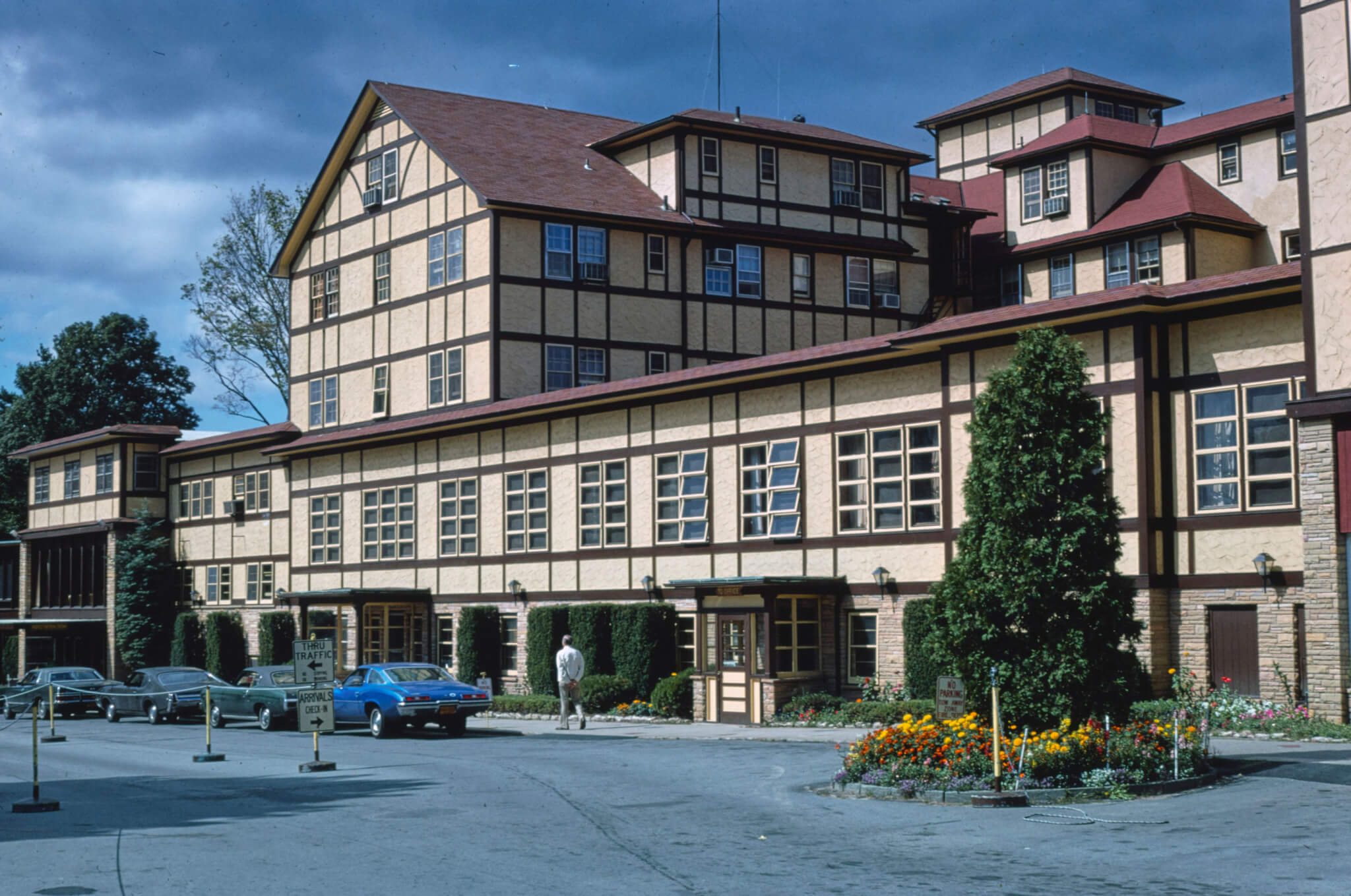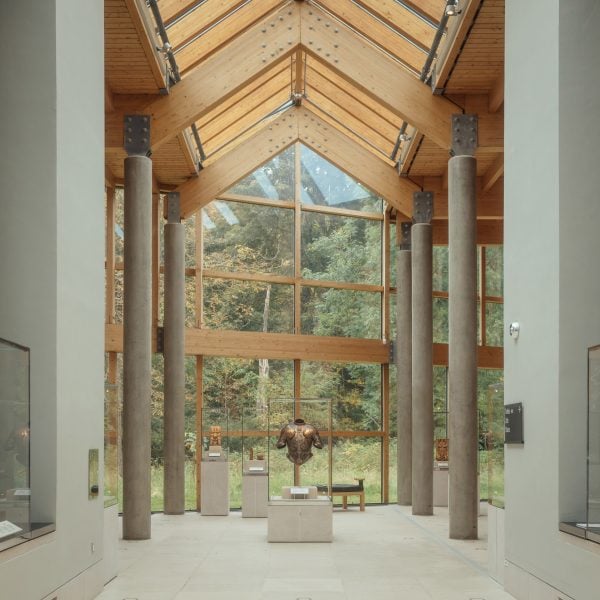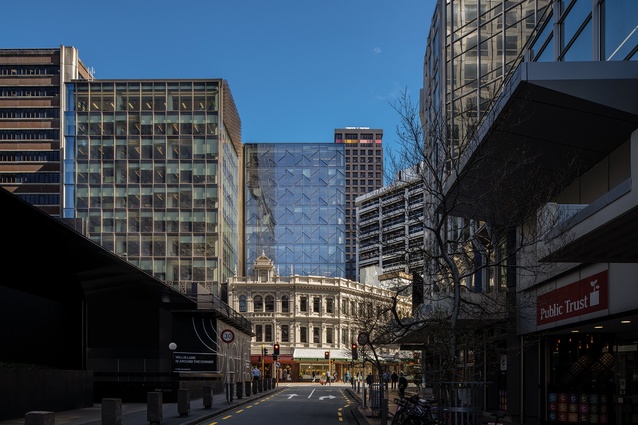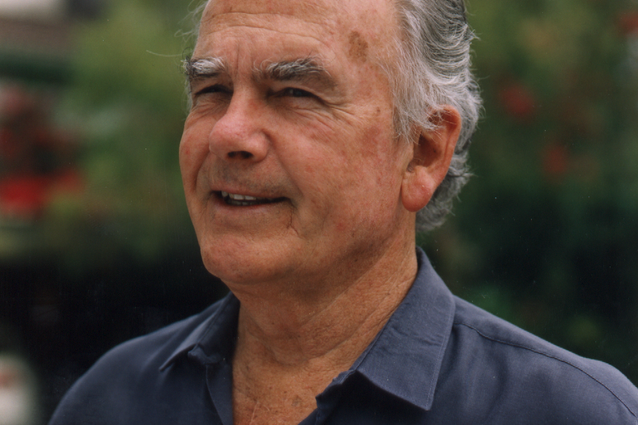Good afternoon and welcome back to another recap of the day’s happenings, including stolen artifacts photoshopped out of an Architectural Digest feature, a fire at the long-abandoned Borscht Belt resort that inspired Dirty Dancing, and the anti-homeless She-Hulk bench sparking debate online. The AN office is closed tomorrow but we’ll be back in action on Monday with the latest news in architecture, urbanism, art, and beyond.
Here’s what you need to know today:
Potentially stolen Cambodian artifacts removed from photographs published by Architectural Digest
A 2020 article published in Architectural Digest showcasing a $42 million San Francisco home occupied by a billionaire’s daughter has resurfaced—and with considerable controversy. Glossy photos document the house’s opulent interiors, designed by architect Peter Marino, and highlight the two-story courtyard and the expansive views of San Francisco Bay and the Golden Gate Bridge. Missing, however, from the published photos are a number of ancient Khmer sculptures, which were said to be photoshopped out of the AD spread.
Depicting gods of Buddhism and Hinduism, the missing stone relics are Cambodian in origin and trace back to the Khmer Empire, which reigned in Cambodia from the 9th to 13th centuries. Photography of the project published on Marino’s website displayed the stone artifacts atop their pedestals, which were empty in the imagery circulated by AD.
The Cambodian government claims the sculptures were likely stolen. Similarly, at the homeowner’s parents house in Palm Beach, Florida, also published in an earlier issue of Architectural Digest, a large collection of the Khmer antiquities was on display. The government is now continuing its effort to have the historical objects returned to their rightful land, but whether that happens remains to be seen. The Washington Post reported that the U.S. Department of Homeland Security has contacted the family in the past about its collection.
As for the doctored photography, a spokesperson for Condé Nast told The Washington Post the objects were erased due to “unresolved publication rights around select artworks.”
H/t to The Washington Post
She-Hulk bench condemned for being anti-homeless
A bench at the Disney screening of the new Marvel film She-Hulk: Attorney at Law has the internet up in arms, literally. The recreational seating debuted at the premiere for the new superhero movie and depicts She-Hulk, played by Tatiana Maslany, in an advertisement for her character’s full-time job as an attorney. Many claim that the armrests placed on the bench render it a work of anti-homeless design.
Why does the she hulk bench have anti homeless architecture https://t.co/nZzm9CTM5l
— Mickey (@Mickeyseidick) August 16, 2022
Hostile or anti-homeless architecture places objects, such as bulky armrests, pointed spikes, leaning bars, and rocks in public locations. It is intentionally designed to deter unhoused people from laying in these places, which often include parks and city streets.
Social media users voiced their opinions on the stunt, with some claiming they will boycott the movie because of it. On Twitter, several users compared the design to the benches featured in the show Better Call Saul, also about a lawyer who plasters his face, phone number, and catchy slogan across benches as a form of advertising, with the one major difference being that Saul Goodman’s benches aren’t hostile.
anti homeless She-Hulk bench
pro homeless Saul Goodman bench ‼️❤️✊ pic.twitter.com/YWS23Wfnbm— coffee (@thesolarcoffee) August 16, 2022
Disney has not released a comment in response.
H/t to Newsweek
HOK to open new office in Miami
International architecture firm HOK has announced it will open an office in Miami. The latest outpost is the firm’s 25th location, joining offices in Beijing, Mumbai, and Dubai, as well as numerous others across the continental United States. This office, located in downtown Coral Gables—just seven miles southwest of downtown Miami—will be HOK’s second location in Florida, its first being Tampa.
The Miami office will be led by Jonathan Rae, senior regional practice leader; Steven Burgos, regional leader of WorkPlace; and Carla Gomez, senior project manager. The studio space will be designed to accommodate a hybrid work environment, with unassigned desks and large gathering spaces that support collaborative work. HOK said the finishes and furnishings for the workspace will “reflect the neighborhood’s personality: bright, fresh, diverse and vibrant.”
The firm, which has an extensive portfolio of commercial projects—spanning disciplines such as healthcare, transportation, and civic—has already completed a number of projects in the Miami area, including work on the new Miami-Dade County Civil Courthouse, the University of Miami Sylvester Comprehensive Cancer Center. It also previously redesigned Hard Rock Stadium, home to the Miami Dolphins.
“We have long had a strong presence in South Florida and are currently working on significant projects in Miami,” said Susan Williams HOK’s managing principal in the announcement. “As full-time members of the community, we look forward to participating more fully in the region’s tremendous energy and growth.
Transformational Cancer Research Building
An abandoned building at the Catskills resort that inspired Dirty Dancing is ravaged by fire
Grossinger’s Catskills Resort Hotel, a long-derelict New York getaway with a storied past, sustained a destructive fire on Wednesday, according to local reports. Whatever remnants of the building that were left standing following the inferno were subsequently razed.
The flames engulfed a three-story wooden building located on the site of the long-forgotten Borsch Belt resort near the town of Liberty. Grossinger’s provided screenwriter Eleanor Bergstein, a frequent guest of the resort during her childhood, with the idea for the plot and backdrop for the 1987 film Dirty Dancing. In its 1960s heyday, the vacation spot comprised 36 buildings spread across a sprawling 1,200 acres, complete with a golf course, lake, ski trails, tennis courts, a post office, and a small airplane runway. In more recent years, Grossinger’s had served as a ruin porn destination par excellence following its closure in 1987 after years of decline. Most of the other structures on the mountainous compound were previously demolished in 2018.
The past use of the building inflicted by the massive fire is unknown, as is what caused the flames. The fire, which proved difficult to combat due to the remote and overgrown nature of the site, is currently under investigation by the New York State Police and Sullivan County Bureau of Fire.
H/t to The New York Times
New York begins accepting applications for adult-use marijuana dispensaries
New York’s Office of Cannabis Management will begin accepting applications for Conditional Adult-Use Retail Dispensary (CAURD) licenses on August 25. This will bring legal adult-use marijuana to main streets, downtowns, and strip malls across New York.
In order to be eligible to set up shop, applicants vying for a license must either have a previous marijuana-related offense conviction, be closely-related to someone convicted for a marijuana conviction, or have experience running a qualifying business, as per the guidelines determined by the Seeding Opportunity Initiative.
“With the Seeding Opportunity Initiative, New York has affirmed our commitment to making sure the first sales are conducted by those harmed by prohibition,” Tremaine Wright, chair of the Cannabis Control Board said in a press statement. “We’re writing a new playbook for what an equitable launch of a cannabis industry looks like, and hope future states follow our lead.”
“This is a monumental step in establishing the most equitable, diverse, and accessible cannabis industry in the nation,” added Executive Director of the Office of Cannabis Management Chris Alexander. “We’ve worked to make this application as simple as possible for all interested applicants, and I cannot emphasize it enough that you do not need any legal expertise to fill this application out.”
New York became one of the 19 U.S. states to legalize pot for public, recreational use in March 2021. The application period for obtaining a CAURD license is one month, closing on September 26, 2022.
University of Toronto names architect Marina Tabassum as its Frank Gehry International Visiting Chair in Architectural Design
Architect Marina Tabassum, head of the eponymous Dhaka–based studio MAT, will serve as the Frank Gehry International Visiting Chair in Architectural Design for 2022–23. The annual position sponsored by the University of Toronto John H. Daniels Faculty of Architecture, Landscape, and Design names one international architect to develop programming, through lectures and classroom experiences, that is shared with students and faculty at the university. It was started in 2000 and named for Toronto-born architect Frank Gehry. Past winners have included Daniel Libeskind (2002–03) and Lina Ghotmeh (2021–22).
During her time as Gehry chair Tabassum will head a MArch research studio focused on the Architecture of Transition, studying issues such as displacement as a result of war and climate.
“The Gehry Chair is a research-based studio. In the era of the Anthropocene, we need to reassess the agendas of architecture and explore the new roles architects can adopt as agents for change,” Tabassum said in a statement published by the university. “The studio will explore current exemplary models being tried out by architects around the world in order to formulate their own ideas.”
Prior to her appointment Tabassum taught at architecture schools in Bangladesh, Europe and the United States, in addition to running her studio MAT, which focuses on humanitarian projects. In 2016, she was the recipient of the Aga Khan Award for Architecture for her design of the Bait ur Rouf Jame Mosque in Bangladesh.
“We are thrilled that Marina will be serving as the Daniels Faculty’s Gehry Chair this year,” added Daniels Dean Juan Du. “Her work uniquely addresses the social and ecological challenges of today through architectural design. With all of her projects, Marina consistently engages local culture and environmental context sensitively and innovatively to create meaningful, enduring architecture for and with communities.”











